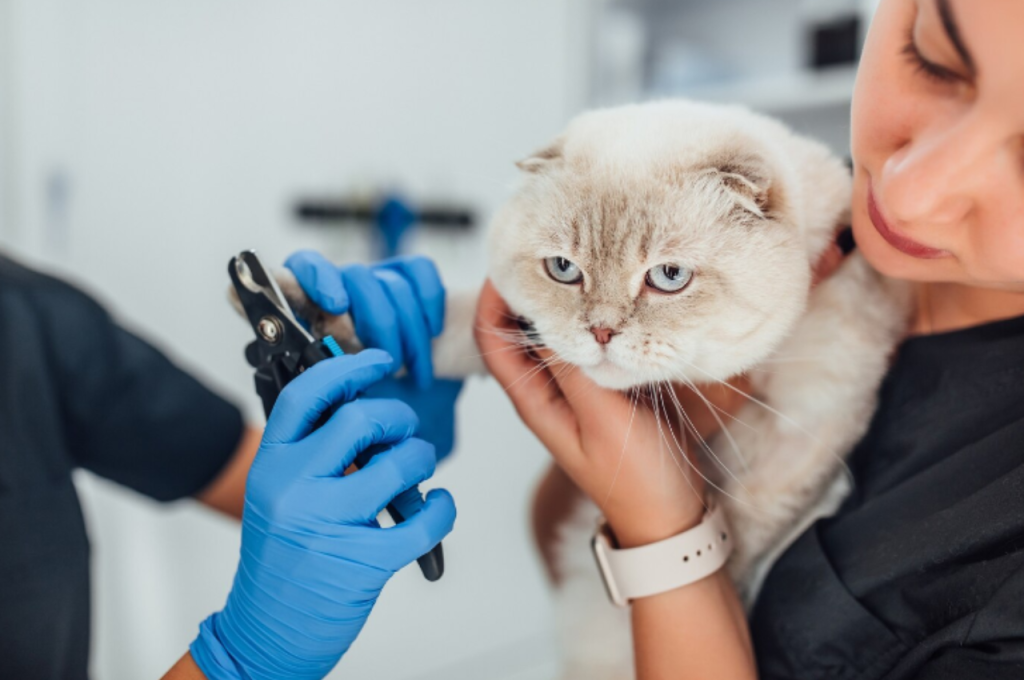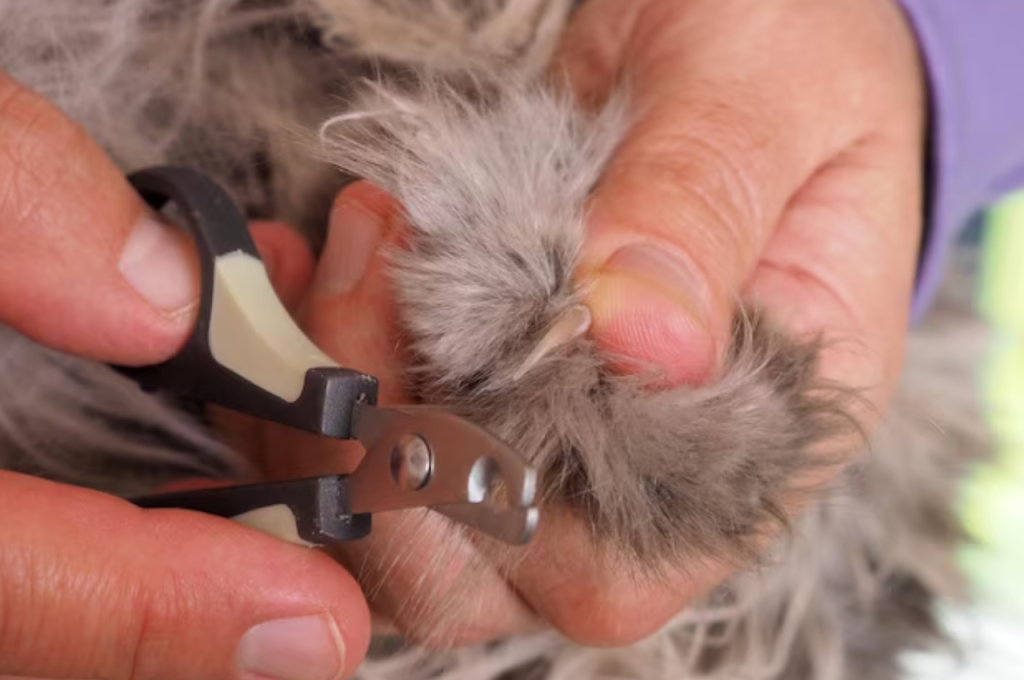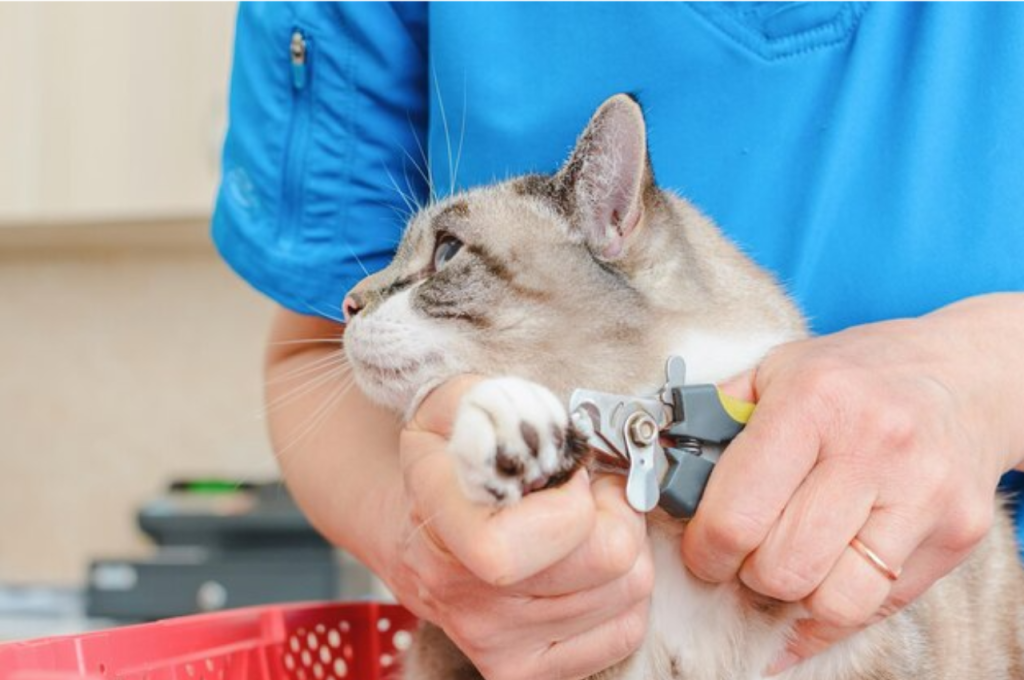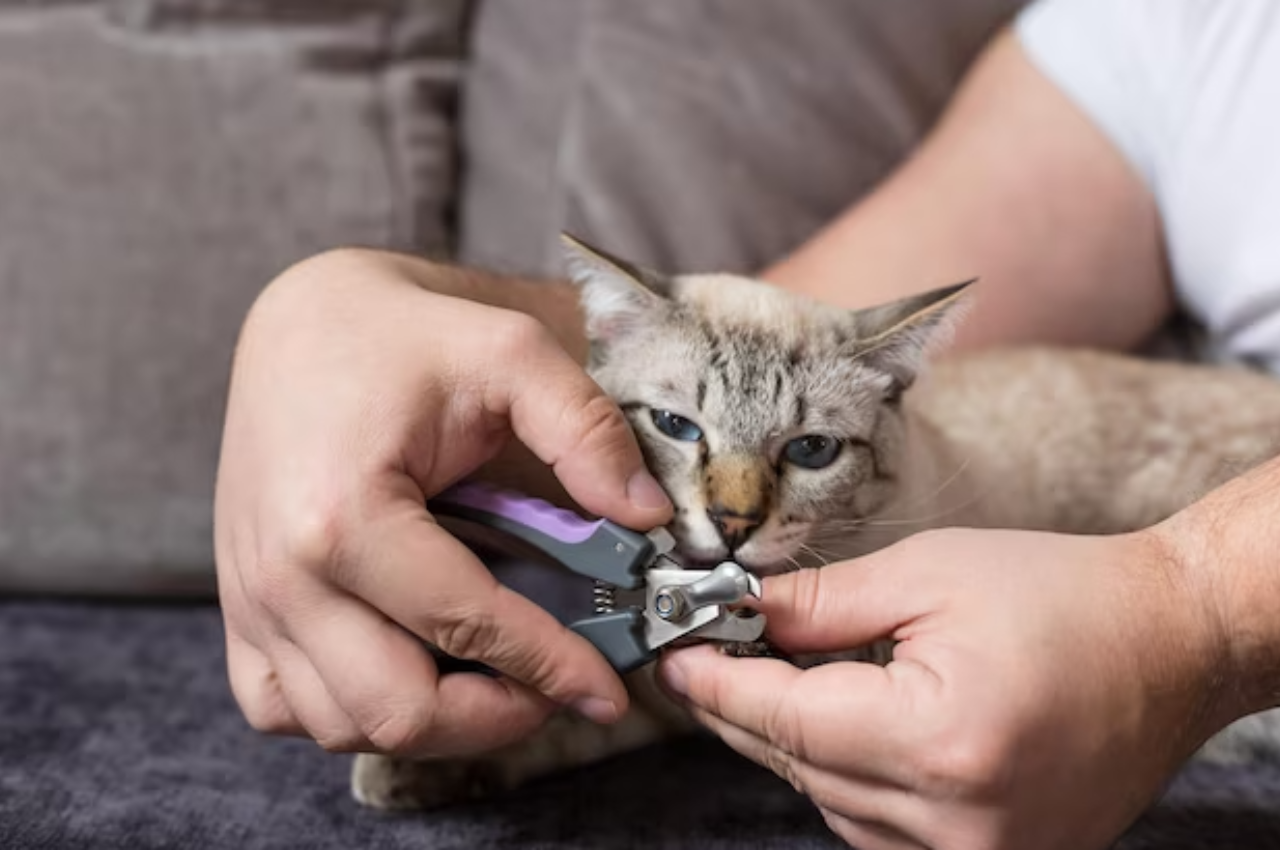To groom cat nails, use cat nail clippers to trim the nails carefully, avoiding the quick. Grooming your cat’s nails is an essential part of their overall hygiene and well-being.
Regular nail trims help prevent ingrown nails, scratches, and damage to furniture and other surfaces. It’s important to approach nail grooming with patience and care to ensure a stress-free experience for both you and your cat. In this blog post, we will guide you through the process of grooming your cat’s nails, providing step-by-step instructions and helpful tips to make the task easier.
By following these guidelines, you can keep your cat’s nails in good condition and maintain a happy and healthy feline companion.
Introduction to Cat Nail Grooming
Cat nail grooming is a crucial aspect of feline care that ensures your cat’s nails remain healthy and manageable. Regular nail trimming helps prevent discomfort and potential injury caused by overgrown nails, which can curl into the paw pads or cause difficulty in walking. Begin by familiarizing your cat with the grooming process to make it less stressful. Use cat-specific nail clippers to trim only the sharp tip of each nail, avoiding the quick, which is sensitive and can bleed if cut. Establish a routine for nail grooming to keep your cat accustomed to the process and reduce anxiety. Proper nail care contributes to overall feline health and comfort.

Benefits of Regular Nail Care
Caring for your cat’s nails is essential for their overall well-being. Regular nail grooming helps prevent painful ingrown nails and reduces the risk of scratching injuries for both your cat and your family members. It also helps maintain your furniture and household items by preventing unnecessary scratching.
Signs Your Cat Needs a Trim
It’s important to pay attention to your cat’s nails to determine when they need a trim. Signs that your cat needs a nail trim include excessive scratching, getting their nails caught in carpets or furniture, and visible overgrowth of the nails. Additionally, if you hear clicking sounds when your cat walks on hard surfaces, it may be time for a trim.
Understanding Your Cat’s Nails
Understanding Your Cat’s Nails is essential for maintaining your feline friend’s overall health and well-being. One crucial aspect of cat grooming is nail care, and by understanding the anatomy and natural growth of your cat’s nails, you can ensure proper maintenance and prevent potential issues.
Anatomy of Feline Claws
Cats have retractable claws consisting of a core of bone surrounded by a sheath of keratin, similar to human nails. The claws are attached to the last bone of each toe and are extended and retracted by muscles and tendons. Understanding this anatomy is key to safely trimming your cat’s nails.
Natural Nail Growth and Maintenance
Cat nails grow continuously and can become overgrown without regular wear and maintenance. Scratching posts and other abrasive surfaces allow cats to naturally shed the outer layers of their claws, keeping them at a healthy length. However, indoor cats may require regular nail trimming to prevent complications.
Preparing for The Grooming Session
Grooming your cat’s nails is an essential part of their care routine. Before you begin the grooming session, it’s important to prepare both mentally and physically. Creating a calm environment and selecting the right tools are crucial steps in ensuring a successful nail grooming experience for your feline friend.
Choosing The Right Tools
Having the appropriate tools is vital for a safe and effective nail grooming session. Invest in high-quality cat nail clippers or scissors specifically designed for felines. Additionally, keep a styptic powder or pencil on hand to stop bleeding in case of accidental cuts. Choosing the right tools will make the grooming process smoother and less stressful for your cat.
Creating a Calm Environment
Creating a tranquil environment is essential for a successful nail grooming session. Choose a quiet room where your cat feels comfortable and secure. Eliminate any potential distractions, such as loud noises or other pets. Ensuring a calm environment will help minimize your cat’s anxiety and make the grooming process more manageable for both of you.
Holding Your Cat Properly
When grooming cat nails, hold your cat firmly but gently to prevent scratching. Support their body and paws for a stress-free experience. Regular nail trims help maintain your cat’s health and prevent furniture damage.
Holding Your Cat Properly is crucial when it comes to grooming their nails. Incorrect handling can lead to scratches or even injuries to you and your furry friend. In this section, we will discuss Safe Handling Techniques and Tips for Restraint and Comfort to ensure a stress-free nail grooming experience for both you and your cat.
Safe Handling Techniques
When holding your cat, it’s essential to keep them calm and relaxed. Here are some safe handling techniques to follow:
- Approach your cat slowly and gently
- Always support their body and limbs
- Never pick up a cat by their scruff
- Keep your cat’s head away from your face to avoid bites or scratches
Tips for Restraint and Comfort
Restraint is necessary when grooming your cat’s nails. However, it’s essential to ensure that your cat is comfortable and relaxed during the process. Here are some tips for restraint and comfort:
- Use a comfortable and secure surface for your cat to stand on
- Wrap your cat in a towel to prevent scratching
- Keep your cat’s head steady by holding their chin with your finger and thumb
- Use treats to keep your cat calm and reward them afterward
Remember, grooming your cat’s nails can be stressful for them, but following these safe handling techniques and tips for restraint and comfort can make the process easier and more comfortable for both you and your feline friend.
The Trimming Process Explained
Learn how to groom cat nails with ease by following these simple steps for the trimming process. Begin by gently holding your cat and using a specialized cat nail clipper to carefully trim the tips of each nail. Be sure to avoid cutting the quick, which can cause pain and bleeding.

Avoiding The Quick
In the trimming process, it is crucial to follow a step-by-step guide to ensure your cat’s nails are groomed safely and effectively.
- First, gather your supplies: cat nail clippers, styptic powder, and treats for rewards.
- Next, choose a quiet area where your cat feels comfortable and secure.
- Hold your cat gently but firmly to prevent squirming.
- Use the clippers to trim the very tip of the nail, avoiding the quick.
- Clip each nail at a slight angle to prevent splintering.
- Reward your cat with treats and praise after each successful trim.
Remember, if you accidentally cut the quick, apply styptic powder to stop bleeding.
Dealing with Accidents
Accidents during cat nail grooming can happen, such as cutting too close to the quick and causing bleeding. If this occurs, stay calm and handle your cat gently. Apply a styptic powder or cornstarch to the nail to stop the bleeding. Press it gently onto the nail and hold for a few moments. Avoid panic and give your cat some time to recover. Make sure to assess your grooming technique to prevent future accidents. If you’re unsure or nervous about nail trimming, consider seeking help from a professional groomer or your veterinarian. Regular practice and proper tools will help you become more comfortable and proficient in grooming your cat’s nails.
First Aid for Nail Bleeding
Accidents can happen during nail grooming, sometimes causing bleeding if the quick is accidentally cut. If your cat’s nail starts to bleed, remain calm and act swiftly. Apply gentle pressure to the nail with a clean cloth or gauze to stop the bleeding. For a more effective solution, use a styptic powder or pencil, which helps to clot the blood and reduce bleeding. If you don’t have these on hand, cornstarch can be used as an alternative. Keep your cat calm and avoid further handling of the affected paw. Monitor the nail and paw for any signs of infection or continued bleeding. If necessary, consult a veterinarian for further assistance. Proper nail grooming techniques can minimize the risk of such accidents.
When to Consult a Veterinarian
When grooming your cat’s nails, it’s important to know when to consult a veterinarian. If you notice any signs of pain, bleeding, or infection while trimming, seek professional help immediately. Additionally, if your cat exhibits extreme anxiety or aggression during nail grooming, a vet can provide advice on how to manage these issues safely. Regular consultations ensure that your cat’s nail health is properly monitored, and a veterinarian can offer guidance on best practices and solutions for any grooming challenges you might encounter. Proper nail care is essential for your cat’s overall well-being, so don’t hesitate to reach out for professional advice if needed.
Training Your Cat for Nail Grooming
Teaching your cat to accept nail grooming can be a gradual process. Start by getting your cat used to having their paws handled. Then, introduce them to the nail clippers and reward them for positive behavior. Consistency and patience are key to successfully training your cat for nail grooming.
Training your cat for nail grooming is a crucial step towards ensuring their claws are healthy and don’t cause any harm to you or your furniture. Positive reinforcement techniques and gradual introduction to nail trimming are two key factors to consider when grooming your cat’s nails.
Positive Reinforcement Techniques
Cats respond well to positive reinforcement, which means that you should reward them for good behavior. Before attempting to trim their nails, it’s important to get your cat used to being handled. Start by petting them gently and offering them treats when they allow you to touch their paws. Once your cat is comfortable with having their paws handled, you can move on to introducing the nail clippers. Show the clippers to your cat and let them sniff and investigate them. Reward them with treats for showing interest. When it’s time to trim their nails, start with one paw and clip only the tip of one nail.
Reward your cat with treats and praise for allowing you to trim their nail. Gradually work your way up to clipping more nails at once, always rewarding good behavior.
Gradual Introduction to Nail Trimming
It’s important to introduce nail trimming gradually to avoid overwhelming your cat. Start by getting your cat used to the sound of the clippers. Turn them on and let your cat investigate the sound. Reward them for showing interest. Once your cat is comfortable with the sound of the clippers, you can move on to touching their paws with the clippers. Start by gently touching their paw with the clippers and rewarding them for allowing you to do so. When it’s time to trim their nails, make sure you have a firm grip on their paw and use the clippers to clip only the tips of the nails. Avoid cutting too close to the quick, which is the pink part of the nail that contains blood vessels and nerves.
In conclusion, training your cat for nail grooming is a gradual process that requires patience and positive reinforcement. By introducing your cat to the nail clippers and rewarding good behavior, you can make the grooming process less stressful for both you and your feline friend.
Alternative Grooming Solutions
Discover alternative grooming solutions for cat nails, including safe and effective techniques to keep your feline friend’s claws in top condition. Learn how to trim cat nails at home to prevent scratching and promote healthy paw care.
Scratching Posts and Boards
Scratching is a natural behavior for cats and it helps them to keep their nails healthy. Providing a scratching post or board is an excellent way to prevent your cat from scratching your furniture. Scratching posts or boards should be tall enough for your cat to stretch out and sturdy enough to support their weight. Place the scratching post or board in an area where your cat likes to scratch, and encourage them to use it by placing toys or treats nearby. Reward your cat with treats and praise when they use the scratching post or board.
Nail Caps as an Option
Nail caps are a safe and humane alternative to declawing. They are made of soft, non-toxic material that covers the cat’s nails, preventing them from scratching surfaces. Nail caps are easy to apply and can last up to six weeks. They come in a variety of colors and sizes to fit your cat’s nails. To apply the nail caps, first, trim your cat’s nails, then fill the nail cap with adhesive and slide it onto the nail. Hold the nail cap in place for a few seconds to allow the adhesive to dry.
Grooming your cat’s nails is an essential part of their overall health and wellbeing. Scratching posts and boards provide an excellent way to keep your cat’s nails healthy and prevent damage to your furniture. Nail caps are a humane alternative to declawing and can prevent your cat from scratching surfaces. By using these alternative grooming solutions, you can keep your cat’s nails healthy and protect your home from damage.
Maintaining Nail Health Between Grooming
Caring for your cat’s nails goes beyond grooming sessions. Proper maintenance between trims is essential to ensure healthy nails.

Diet and Nutrition for Strong Nails
A balanced diet rich in protein and essential nutrients supports strong nail growth.
- Feed your cat high-quality cat food.
- Include Omega-3 fatty acids in their diet.
- Consult your vet for specialized nail health supplements.
Regular Inspections and Care Tips
Regularly check your cat’s nails for signs of overgrowth or damage.
- Trim nails every 2-3 weeks.
- Provide scratching posts to help naturally file down nails.
- Watch for any changes in nail color or texture.
Conclusion
Grooming your cat’s nails is an essential part of their overall care. By following the steps outlined in this blog post, you can ensure that the process is safe and stress-free for both you and your feline friend. Regular nail trims not only prevent scratching accidents but also promote healthy paw maintenance.
Remember to use the right tools and be patient with your cat during the grooming process. With practice and consistency, you can easily master the art of cat nail grooming.
